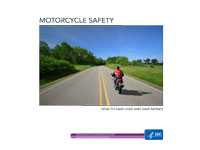Motorcycle Safety

Motorcycle crash deaths are costly, but preventable. The single most effective way for states to save lives and save money is a universal helmet law.
- Helmets saved an estimated 1,772 lives in 2015.1
- If all motorcyclists would have worn helmets in 2015, 740 more could have been saved.
- Each year, the United States could save more than $1billion if all motorcyclists wore helmets.2
- Helmets reduce the risk of death by 37%.2
- Helmets reduce the risk of head injury by 69%.3,4
“Our role is to identify ways to prevent injury and death and rigorously check what works and what does not work. For motorcycle safety, the research shows that universal helmet laws are the most effective way to reduce the number of deaths and traumatic brain injuries that result from crashes.”
– Dr. Thomas Frieden, former CDC Director
Motorcycle Safety Guide

Note: This document does not contain current data and is included for historical purposes only.
Motorcycle Crash Deaths

Motorcycle Fatality Facts from the Insurance Institute for Highway Safety.
Additional Information
References
- National Center for Statistics and Analysis. Washington, DC: March 2017. Motorcycles (Traffic Safety Facts Research Note. Report No. DOT HS 812 353). Available at http://www-nrd.nhtsa.dot.gov/Pubs/812353.pdf. Accessed May 19, 2017.
- National Center for Statistics and Analysis. Washington, DC: October 2015. Estimating lives and costs saved by motorcycle helmets with updated economic cost information (Traffic Safety Facts Research Note. Report No. DOT HS 812 206). Available at http://www-nrd.nhtsa.dot.gov/Pubs/812206.pdf. Accessed May 19, 2017.
- Derrick AJ, Faucher LD. Motorcycle helmets and rider safety: A legislative crisis. J Public Health Pol. 2009;30(2):226–242.
- Liu BC, Ivers R, Norton R, Boufous S, Blows S, Lo SK. Helmets for preventing injury in motorcycle riders. Cochrane Database Syst Rev. 2008;(1):CD004333. doi: 10.1002/14651858.CD004333.pub3
- Page last reviewed: May 31, 2017
- Page last updated: May 31, 2017
- Content source:
- Centers for Disease Control and Prevention,
- National Center for Injury Prevention and Control,
- Division of Unintentional Injury Prevention


 ShareCompartir
ShareCompartir
